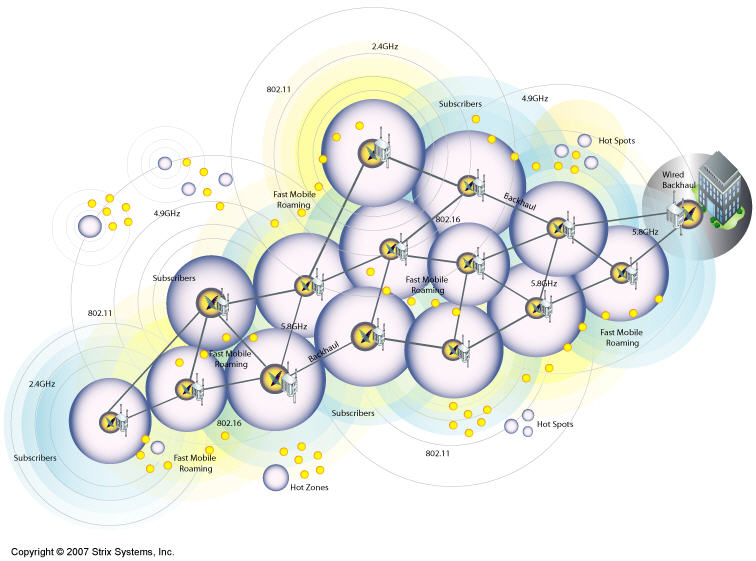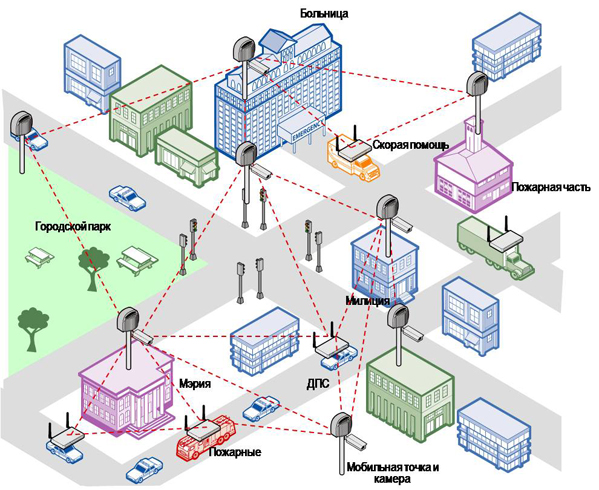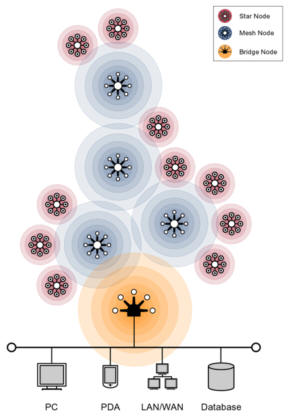Wireless Mesh Network or IEEE 802.11s standard (version 1.0)
Wireless Mesh Network as an alternative to WiMAX
Hello. To begin with, this article is an introduction to the WMN topic. The very idea of creating me threw my supervisor. The end result is the creation of software that allows you to quickly deploy WMN using any device with a WiFi network adapter that supports standards b or g, and best of all is standard n. this will reduce the likelihood of breaking the link when switching between mesh zones, and increase the data transfer rate.

The technology in question - Wireless Mesh (an alternative to WiMAX) (mesh networks, also called multisite, mesh peer-to-peer, multi-hop, networks) is formed on the basis of many point-to-point connections friend, extends the functionality of wireless Internet access and allows you to implement access points with a coverage that is an order of magnitude higher than that of conventional hot spots. With the ability to provide secure wireless coverage both indoors and on the streets, in urban areas or in large population centers, Wireless Mesh can be used for rapid deployment, in particular, a communications network for internal security purposes or in cases of emergency in the city.
')
To understand the advantages of networks of cellular topology, it is worth comparing them with single-hop networks. In a traditional 802.11 wireless network, multiple clients connect directly to an access point. Such networks are called single-node. In a multi-site network, any device with wireless capabilities is able to act as both a router and an access point.
If the nearest access point is overloaded, the data is redirected to the nearest unloaded node. The data block continues to move from one node to another until it reaches its destination.

The network processor, logic and wireless interface are concentrated inside each node - member of the network, so the need for centralized switching disappears. In other words, the topology of cellular networks provides either a direct connection between the nodes that form them or transit data transmission between the source and the receiver. Therefore, before starting data exchange, each node must “decide” whether it will perform the functions of an access point, serve as a transit device, or combine both roles. Next, individual nodes determine their neighbors using a request / response protocol. After the detection procedure is over, the nodes measure the characteristics of the communication channels: the received signal power, throughput, delay, and error rate. Nodes exchange these values, and then, based on them, each node chooses the best communication route with its neighbors.
The processes of detecting and selecting the most favorable route are performed in the background, so that each node has an actual list of neighbors. In case of inaccessibility, for one reason or another, a node can quickly reconfigure its tables and calculate a new optimal route. The ability of self-configuration and self-healing makes cellular networks very reliable. Wireless mesh networks can consist of hundreds or even thousands of nodes, which makes it easy to expand them and provide the necessary redundancy.
At shorter distances, network bandwidth is higher. The reason may be interference and other factors affecting the loss of data, whose action accumulates with increasing distance. And because one of the ways to increase network bandwidth becomes data transmission through several nodes separated by small distances. Due to the fact that for transmitting data over shorter distances, less power is required, a multisite network can provide higher overall throughput.

Nodes remain completely autonomous devices capable of managing their operation independently, and at the same time they are a component of the general network that allows control from a central point.
I think for version 1.0 is enough
PS: Today, this technology is already implemented in Linux, starting with the 2.6.26 kernel and in FreeBSD 8.
Already, we are testing the WMN implemented by us for Windows and Mac. The goal is to give everyone the opportunity to deploy a WM network.
I'm interested in hearing your opinion about WMN, and if this topic is interesting, then in “version 1.1” I will talk about already implemented mesh networks in cities, with a detailed description.
Thank you all for reading. Have a good day.
Introduction:
Hello. To begin with, this article is an introduction to the WMN topic. The very idea of creating me threw my supervisor. The end result is the creation of software that allows you to quickly deploy WMN using any device with a WiFi network adapter that supports standards b or g, and best of all is standard n. this will reduce the likelihood of breaking the link when switching between mesh zones, and increase the data transfer rate.

In more detail:
The technology in question - Wireless Mesh (an alternative to WiMAX) (mesh networks, also called multisite, mesh peer-to-peer, multi-hop, networks) is formed on the basis of many point-to-point connections friend, extends the functionality of wireless Internet access and allows you to implement access points with a coverage that is an order of magnitude higher than that of conventional hot spots. With the ability to provide secure wireless coverage both indoors and on the streets, in urban areas or in large population centers, Wireless Mesh can be used for rapid deployment, in particular, a communications network for internal security purposes or in cases of emergency in the city.
')
Advantages of 802.11s:
To understand the advantages of networks of cellular topology, it is worth comparing them with single-hop networks. In a traditional 802.11 wireless network, multiple clients connect directly to an access point. Such networks are called single-node. In a multi-site network, any device with wireless capabilities is able to act as both a router and an access point.
If the nearest access point is overloaded, the data is redirected to the nearest unloaded node. The data block continues to move from one node to another until it reaches its destination.

The technical side of the issue:
The network processor, logic and wireless interface are concentrated inside each node - member of the network, so the need for centralized switching disappears. In other words, the topology of cellular networks provides either a direct connection between the nodes that form them or transit data transmission between the source and the receiver. Therefore, before starting data exchange, each node must “decide” whether it will perform the functions of an access point, serve as a transit device, or combine both roles. Next, individual nodes determine their neighbors using a request / response protocol. After the detection procedure is over, the nodes measure the characteristics of the communication channels: the received signal power, throughput, delay, and error rate. Nodes exchange these values, and then, based on them, each node chooses the best communication route with its neighbors.
The processes of detecting and selecting the most favorable route are performed in the background, so that each node has an actual list of neighbors. In case of inaccessibility, for one reason or another, a node can quickly reconfigure its tables and calculate a new optimal route. The ability of self-configuration and self-healing makes cellular networks very reliable. Wireless mesh networks can consist of hundreds or even thousands of nodes, which makes it easy to expand them and provide the necessary redundancy.
Physical properties of wireless channels:
At shorter distances, network bandwidth is higher. The reason may be interference and other factors affecting the loss of data, whose action accumulates with increasing distance. And because one of the ways to increase network bandwidth becomes data transmission through several nodes separated by small distances. Due to the fact that for transmitting data over shorter distances, less power is required, a multisite network can provide higher overall throughput.

Nodes remain completely autonomous devices capable of managing their operation independently, and at the same time they are a component of the general network that allows control from a central point.
I think for version 1.0 is enough
PS: Today, this technology is already implemented in Linux, starting with the 2.6.26 kernel and in FreeBSD 8.
Already, we are testing the WMN implemented by us for Windows and Mac. The goal is to give everyone the opportunity to deploy a WM network.
I'm interested in hearing your opinion about WMN, and if this topic is interesting, then in “version 1.1” I will talk about already implemented mesh networks in cities, with a detailed description.
Thank you all for reading. Have a good day.
Source: https://habr.com/ru/post/79360/
All Articles